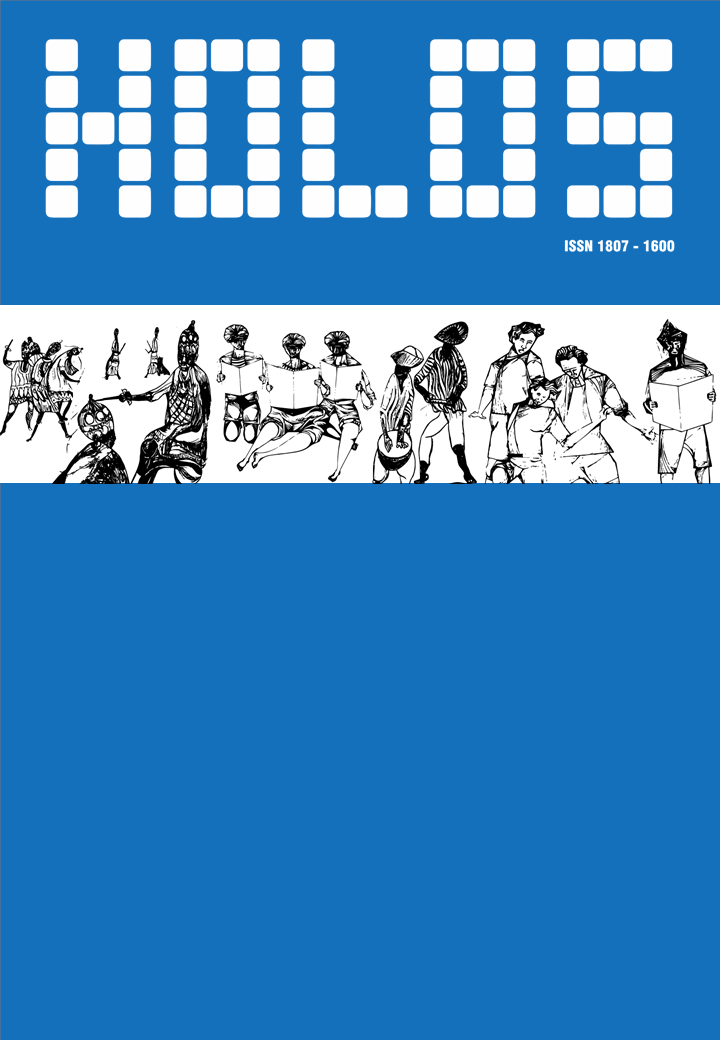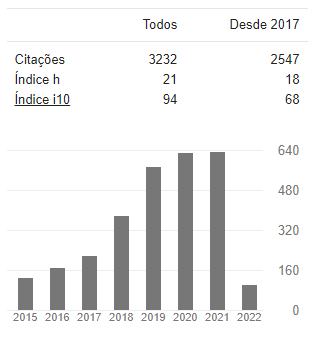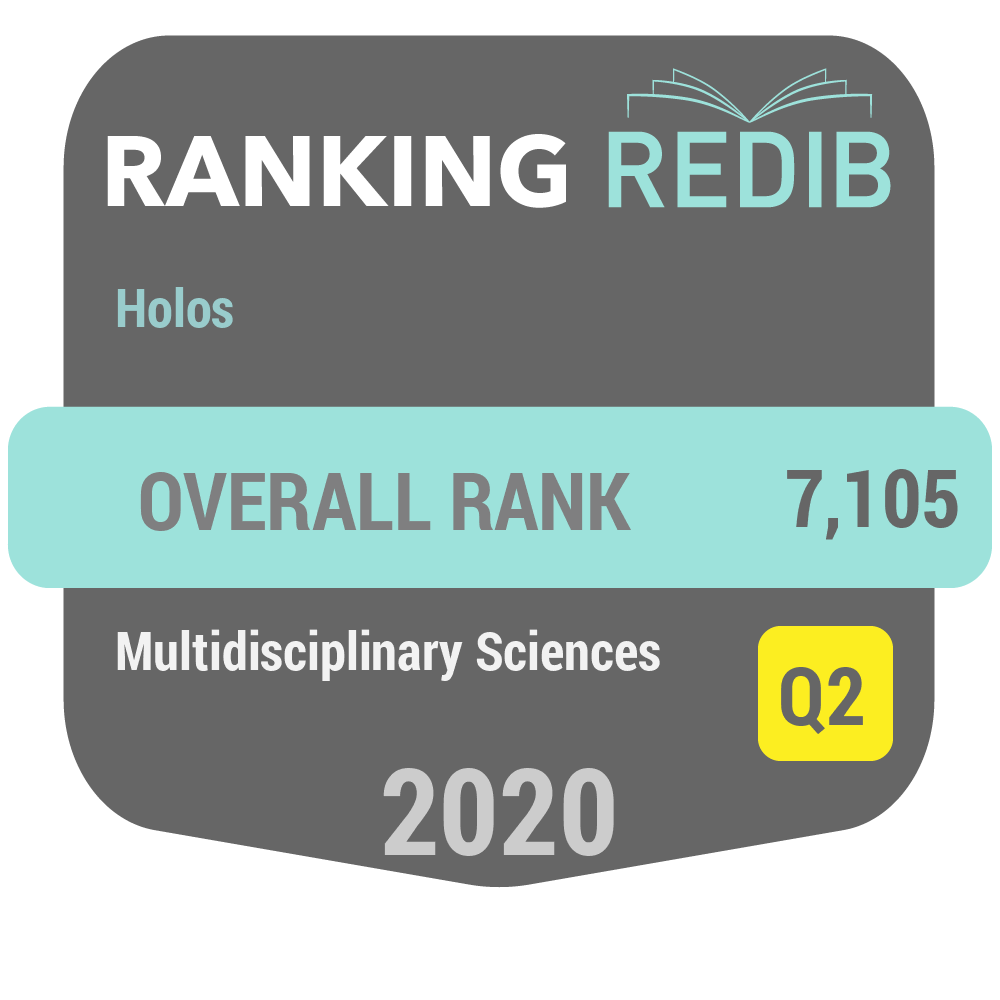Extraction method optimization and the seasonal effect in the biological activities and phenolic compounds of Brazilian green propolis
DOI:
https://doi.org/10.15628/holos.2021.11316Palavras-chave:
antioxidant, antibacterial activity, natural products, total phenols, seasonality.Resumo
Propolis has been considered a resinous substance with a complex chemical composition that is collected from several plant species by Apis mellifera bees, and used by man as an alternative to the healing of diseases and to keep a good health. The chemical composition of propolis is related to the biodiversity of the region visited by the bees and also to the season of collection. This research purpose was to optimize the production methodology of propolis’ ethanol extract production and to evaluate the effect of seasonality in the chemical composition and biological activities of this product. Propolis’ samples were collected from the apiary at the Instituto Federal de Educação, Ciência e Tecnologia do Sul de Minas Gerais - Campus Muzambinho and were used to make ethanol extracts. In the optimization stage, different ethanolic solution concentration, extraction method and drying temperatures were used. For the analysis of the seasonal effect, propolis was collected from the same place in different seasons. The results showed that the 80% ethanolic solution, the extraction temperature of 70oC and drying at 45oC were the ones that stood out the most. Regarding the effect of seasonality on the chemical composition and biological activities of propolis, it is clear that there are differences between the propolis collected in different seasons.
Downloads
Referências
Batista, M. C. A., Batista, M. C. S., Sobrinho, J. A. N., Trindade, H. I., Silva, L. L. B., & Muller, J. B. B. S. (2016). Chemical composition and antioxidant activity of geopropolis produced by Melipona fasciculata (Meliponinae) in flooded fields and cerrado areas of Maranhão State, northeastern Brazil. Acta Amazonica, 46 (3), 315–322. doi: 10.1590/1983-084X/12_116. DOI: https://doi.org/10.1590/1809-4392201600034
Brand-Williams, W., Cuvelier, M. E., & Berset, C. (1995). Use of a free radical method to evaluate antioxidant activity. Lwt - Food Science and Technology, 28 (1), 25-30. doi: 10.1016/S0023-6438(95)80008-5. DOI: https://doi.org/10.1016/S0023-6438(95)80008-5
Brazil – Ministry of Agriculture, Livestock and Supply. (2001). Instrução Normativa n. 3 de 2001. Regulamentos Técnicos de Identidade e Qualidade de Apitoxina, Cera de Abelha, Geléia Real, Geléia Real Liofilizada, Pólen Apícola, Própolis e Extrato de Própolis [Normative Instruction no. 3, 2001. Technical Regulations on Identity and Quality of Apitoxin, Beewax, Royal Jelly, Lyophilized Royal Jelly, Bee Pollen, Propolis and Propolis Extract]. Brasilia, Brazil: Official Diary of the Union.
Cabral, I. S. R., Oldoni, T. L. C., Alencar, S. M., Rosalen, P. L., & Ikegaki, M. (2012). The correlation between the phenolic composition and biological activities of two varieties of Brazilian própolis (G6 and G12). Brazilian Journal of Pharmaceutical Sciences, 48 (3). doi 10.1590/S1984-82502012000300023. DOI: https://doi.org/10.1590/S1984-82502012000300023
Castro, M. L. Cury, J. A., Rosalen, P. L., Alencar, S. M., Ikegaki, M., Duarte, S., & Koo, H. (2007). Propolis from southeastern and northeastern of Brazil: the influence of seasonality in antibacterial activity and phenolic composition. Química Nova, 30 (7), 1512-1516. doi: 10.1590/S0100-40422007000700003. DOI: https://doi.org/10.1590/S0100-40422007000700003
CLSI. (2015). Methods for dilution antimicrobial susceptibility tests for bacteria that grow aerobically. Vol. 35, n. 2. Wayne, PA: Clinical and Laboratory Standards Institute.
Ferreira, D. F. (2014). Sisvar: a Guide for its Bootstrap procedures in multiples comparisons. Ciência e Agrotecnologia, 38, (2). doi: 10.1590/S1413-70542014000200001 DOI: https://doi.org/10.1590/S1413-70542014000200001
Ferreira, V. U. (2017). Chemical characterization, antioxidant, anti-leukemic and antimicrobial activities of Southern Brazilian amber propolis (Master’s thesis). Retrieved from http://dspace.unipampa.edu.br:8080/jspui/handle/riu/1467.
Franchin, M., Rosalen, P. L., Cunha, M. G., Silva, R. L., Cólon, D. F., Bassi, G. S., … Cunha, T. M. (2016). Cinnamoyloxy-mammeisin Isolated from Geopropolis Attenuates Inflammatory Process by Inhibiting Cytokine Production: Involvement of MAPK, AP-1, and NF-?B. Journal of Natural Products, 79 (7), 1828–1833. doi: 10.1021/acs.jnatprod.6b00263. DOI: https://doi.org/10.1021/acs.jnatprod.6b00263
Fríon-Herrera, Y. F., Díaz-García, A., Ruiz-Fuentes, J., Rodriguez-Sánchez, H., & Sforcin, J. M. (2015). Brazilian green propolis induced apoptosis in human lung cancer A549 cells through mitochondrial-mediated pathway. Journal of Pharmacy and Pharmacology, 67 (10), 1448-56. doi: 10.1111/jphp.12449. DOI: https://doi.org/10.1111/jphp.12449
Gomes, M. F. F., Ítavo, C. C. B. F., Leal, C. R. B., Ítavo, L. C. V., & Lunas, R. C. (2016). In vitro antibacterial activity of brown propolis. Pesquisa Veterinária Brasileira, 36, (4), 279-282. DOI: https://doi.org/10.1590/S0100-736X2016000400005
Groot, A. C. (2013). Propolis: a review of properties, applications, chemical composition, contact allergy, and other adverse effects. American Contact Dermatitis Society, 24 (6), 263-82. doi: 10.1097/DER.0000000000000011. DOI: https://doi.org/10.1097/DER.0000000000000011
Kujumgiev, A., Tsvetkova, I., Serkedjieva, Y., Bankova, V., Christov, R., & Popov, S. (1999). Antibacterial, antifungal and antiviral activity of propolis of different geographic origin. Journal Of Ethnopharmacology, 64 (3), 235-240. doi: 10.1016/s0378-8741(98)00131-7. DOI: https://doi.org/10.1016/S0378-8741(98)00131-7
Machado, C. S., Mokochinski, J. B., Lira, T. O., Oliveira, F. C. E., Cardoso, M. V., Ferreira, & R. G. Torres, Y. R. (2016). Comparative study of chemical compositions and biological activity of yellow, green, brown, and red Brazilian propolis. Evidence-Based Complementary and Alternative Medicine. doi: 10.1155/2016/6057650. DOI: https://doi.org/10.1155/2016/6057650
Machado, J. L., Assunção, A. K., Silva, M. C., Reis, A. S., Costa, G. C., Arruda, D. S., ... Nascimento, F. R. (2012). Brazilian green propolis: anti-inflammatory property by an immunomodulatory activity. Evidence-Based Complementary and Alternative Medicine. doi: 10.1155/2012/157652. DOI: https://doi.org/10.1155/2012/157652
Marcucci, M.C. (1995). Propolis: Chemical composition, biological properties and therapeutic activity. Apidologie, 26 (2), 83–99. DOI: https://doi.org/10.1051/apido:19950202
Melo, A. A. M., Matsuda, A. H., & Almeida-Muradian, L. B. (2012). Identity and quality of propolis from four regions of Brazil. Revista Instituto Adolfo Lutz, 71 (3).
Monry, Y. M., Rodney, A. F. R., Rodrigues, M. V. N., Sant’ana, A. S., Silva, B. S., & Cabral, F. A (2017). Brazilian green propolis extracts obtained by conventional processes and by processes at high pressure with supercritical carbon dioxide, ethanol and water. The Journal of Supercritical Fluids, 130, 189-197. doi: 10.1016/j.supflu.2017.08.006. DOI: https://doi.org/10.1016/j.supflu.2017.08.006
Pandolfo, V. Z. (2014). Characterization and effect of the seasonal variation of organic propolis produced in Southern Brazil (Master’s thesis). Retrieved from https://teses.usp.br/teses/disponiveis/11/11141/tde-05012015-154728/pt-br.php.
Park, Y. K., Ikegaki, M., Abreu, J. A. S., & Alcici, N. M. F. (1998). Study of the preparation of the propolis extracts and its application. Ciência e Tecnologia de Alimentos, 18 (3), 313-318. doi: 10.1590/S0101-20611998000300011. DOI: https://doi.org/10.1590/S0101-20611998000300011
Pasupuleti, V. R. Sammugam, L., Ramesh, N., & Gan, S. H. (2017). Honey, propolis, and royal jelly: a comprehensive review of their biológica actions and health benefits. Oxidative Medicine and Cellular Longevity. doi: 10.1155/2017/1259510. DOI: https://doi.org/10.1155/2017/1259510
Paulino, N., Teixeira, C., Martins, R., Amarilis, S., Dirsch, V. M., Vollmar, A. M., … Marcucci, M. C. (2006). Evaluation of the Analgesic and Anti-Inflammatory Effects of a Brazilian Green Propolis. Planta Médica, 72 (10), 899-906. doi: 10.1055/s-2006-947185. DOI: https://doi.org/10.1055/s-2006-947185
Peter, C. M., Picoli, T., Zani, J. L., Latosinski, G. S., Lima, M., Vargas, G. D., … Fischer, G. (2017). Antiviral and virucidal activity of hydroalcoholic extracts of propolis brown, green and jataí bees (Tetragonisca angustula) against Bovine Herpesvirus Type-1 (BoHV-1) and Bovine Viral Diarrhea Virus (BVDV). Pesquisa Veterinária Brasileira, 37 (7). doi: 10.1590/s0100-736x2017000700003. DOI: https://doi.org/10.1590/s0100-736x2017000700003
Salgueiro, F. B., & Castro, R. N. (2016) Comparison between chemical composition and antioxidant activity of different extracts of green propolis. Química Nova, 39, (10), 1192-1199. doi: 10.21577/0100-4042.20160136. DOI: https://doi.org/10.21577/0100-4042.20160136
Schmidt, E. M., Strock, D., Chada, F. J. G., Finger, D., Sawaya, A. C. H. F., Eberlin, M. N., … Torres, Y. R. (2014). A comparison between characterization and biological properties of Brazilian fresh and aged propolis. BioMed Research International. doi: 10.1155/2014/257617. DOI: https://doi.org/10.1155/2014/257617
Sforcin, J. M., Fernandes, A. J., Lopes, C. A., Bankova, V., & Funari, S. R. (2000). Seasonal effect on Brazilian propolis antibacterial activity. Journal of Ethnopharmacology, 73 (1), 243-249. doi: 10.1016/s0378-8741(00)00320-2. DOI: https://doi.org/10.1016/S0378-8741(00)00320-2
Shimazawa, M., Chikamatsu, S., Morimoto, N., Mishima, S., Nagai, H., & Hara, H. (2005). Neuroprotection by Brazilian green propolis against in vitro and in vivo ischemic neuronal damage. Oxford University Press, 2 (2), 201-207. doi: 10.1093/ecam/neh078. DOI: https://doi.org/10.1093/ecam/neh078
Silva, J. F. M., Souza, M. C., Matta, S. R., Andrade, M. R., & Vidal, F. V. N. (2006). Correlation analysis between phenolic levels of Brazilian propolis extracts and their antimicrobial and antioxidant activities. Food Chemistry, 99 (3), 431-435. doi: 10.1016/j.foodchem.2005.07.055. DOI: https://doi.org/10.1016/j.foodchem.2005.07.055
Silva, S. S., Miranda, M. M., Costa, I. N., Watanabe, M. A. E., Pavanelli, W. R., Felipe, I., … Conchon-Costa, I. (2015). Leishmanicidal activity of brazilian propolis hydroalcoholic extract in Leishmania amazonensis. Semina: Ciências Biológicas e da Saúde, 36 (2), 25-34. doi: 10.5433/1679-0367.2015v36n2p25. DOI: https://doi.org/10.5433/1679-0367.2015v36n2p25
Singleton, V. L., Orthofer, R., & Lamuela-Raventós, R. M. (1999). Analysis of total phenols and other oxidation substrates and antioxidants by means of Folin-Ciocalteu reagent. Oxidants and Antioxidants part A, 299, 152-178. doi: 10.1016/S0076-6879(99)99017-1. DOI: https://doi.org/10.1016/S0076-6879(99)99017-1
Souza, E. A., Inoue, H. T., Gomes, S. M. A., Funari, S. R. C., & Orsi, R. O. (2010). Physicochemical properties of propolis in function of seasonality and production method. Archivos de zootecnia, 59 (228), 571-576. DOI: https://doi.org/10.21071/az.v59i228.4712
Tiveron, A. P., Rosalen, P. L., Franchin, M., Lacerda, R. C., Bueno-Silva, B., Benso, B., ... Alencar, S. M. (2016). Chemical characterization and antioxidant, antimicrobial, and anti-inflammatory activities of South Brazilian organic propolis. PLoS ONE, 11 (11), 1–11. doi: 10.1371/journal.pone.0165588. DOI: https://doi.org/10.1371/journal.pone.0165588
Uzel, A., Sorkun, K., Onçag, O., Cogulu, D., Gençay, O., & Salih, B. (2005). Chemical compositions and antimicrobial activities of four different Anatolian propolis samples. Microbiological Research, 160 (2), 189-195. doi: 10.1016/j.micres.2005.01.002. DOI: https://doi.org/10.1016/j.micres.2005.01.002
Wagh, V. D. (2013). Propolis: a wonder bees product and its pharmacological potentials. Advances in Pharmacological Sciences. doi: 10.1155/2013/308249. DOI: https://doi.org/10.1155/2013/308249









































